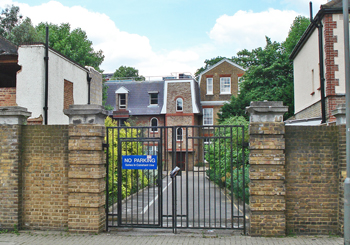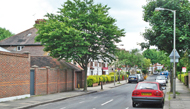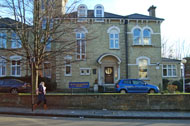Chronic, geriatric
It was decided in the 1920s that a home was needed where chronically ill and dying members of the Jewish community could be nursed under the conditions of their own faith. A group was formed, led by Moss Harris and Bernhard Baron, to raise money for the project.
A secluded site, lying behind some small private houses, was found in Birchlands Avenue, Wandsworth Common, and the Jewish Home of Rest opened in April 1928 with 30 beds.
The Home was located in the centre of the long and narrow site, with the mortuary to the south and the laundry and various out-buildings to the north, which were shared with the adjacent Home for Aged Jews in Nightingale Lane.
The Home of Rest was divided into two sections - one for the aged and infirm and the other for the dying. The latter had 16 beds in single rooms and 2-3 bedded wards on the ground floor and offered similar facilities to those at St Luke's House and St Columba's Hospitalfor male and female patients in the advanced stages of TB, cancer or cardiac failure who were not expected to live more than six months. This section was staffed by a Sister and 4 Assistant Matrons. The first floor contained the 'infirmary' section with 20 beds for those aged over 60 years.
In 1930 the weekly cost of an in-patient was £3 13s 3d (£3.66), compared to 1929, when it was £3 3s 11d (£3.20). However, the Home received many gifts - furniture, bedding, crockery, cutlery, etc., provisions, fruit, flowers, clothing and underclothing, wireless sets and headphones, wheelchairs, hot water bottles and cigarettes.
In summer the beds were wheeled out into the open and the Home had an atmosphere more like a West End nursing home than a public institution.
In 1930 a large mansion in the neighborhood, Helensburgh House at 99 Nightingale Lane, was bought for use as a Nurses' Home. Up until then the nurses had lived on the second floor of the Home, but it was decided that the nature of their work, with constant deaths, placed too great a strain on them to continue living in the same building as their patients.
In 1935 the management committee decided to convert the vacated second floor into more patient accommodation. The increase of the bed complement would necessitate an increase in staff to 20 nurses, including Matron, and 12 maids, so it was also decided to build a new Nurses' Home at the south of the site. The mortuary would be demolished and rebuilt in a more suitable place at the north of the site.
The Nurses' Home in Nightingale Lane was sold for £5,800 (the building later became the Queen Elizabeth Maternity Home) and building work began on the new L-shaped 3-storey Nurses' Home. The second floor of the Home of Rest was converted into several small wards - one with 5 beds and one with 4, two with 3 beds and three single rooms - providing 18 extra beds. Six of the beds were for dying patients. This floor also contained a duty room, a kitchen, a sewing room, a storeroom, two bathrooms and two WCs. The project had cost £16,050.
During WW2, in September 1940, 21 beds for chronic patients had to be closed due to lack of funds (the Home's 54 beds cost £8,000 a year to maintain). Fourteen of the patients were transferred to various Council hospitals and the remaining seven were sent home.
An arrangement was made with the LCC to
admit TB patients referred by its Medical Office of Health. In
October 1940 the LCC agreed to pay 49 shillings (£2.45) a week
for each of its patients, an increase from 42 shillings £2.10)
previously (although TB patients cost £3 10 shillings
(£3.50) to maintain).
Rebuilding started almost at once and had almost been completed, when the Home was taken over by the Ministry of Health as part of the NHS in 1948. It came under the control of the Wandsworth Hospital Group.
In February 1949, the first stage of rebuilding was completed and the Home reopened with 23 beds. Plans were made to extend the Home in the future and to make it as modern as possible, particularly in the kitchen where Jewish ritual required that meat and milk dishes be kept entirely separate. Labour-saving devices and up-to-date developments in hospital architecture were all part of the scheme. When completed, the Home would have 84 beds.
By 1952 it had still not proved possible to proceed with the scheme, but a new bungalow for the Matron and Assistant Matron was built in the grounds for £2,800. It was designed so that it could be incorporated into any future extension of the Home.
In 1965 an extension was completed for £34,000.
In 1979, when the Home had 34 beds, it amalgamated with Nightingale the neighbouring nursing home formerly known as the Home for Aged Jews.
Present status (June 2008)
The only trace of the Home are the old gateposts in Birchland Avenue, leading presumably to Birchlands Way and Nightingale House.

The old gateposts of the Home in Birchlands Avenue.

Birchlands Avenue, with the gateposts on the left.

The former Nurses' Home at 99 Nightingale Lane later became the Queen Elizabeth Maternity Home. Today it is Queen Elizabeth House, sheltered housing managed by the Wandle Housing Association.
http://hansard.millbanksystems.com (1961)
http://hansard.millbanksystems.com (1965)
www.flyingbombsandrockets.com
www.jvn.org.uk
Return to home page